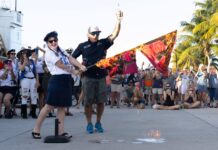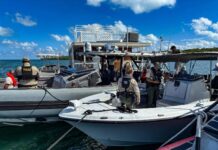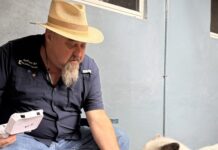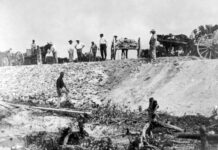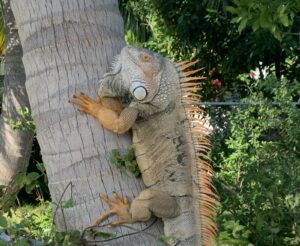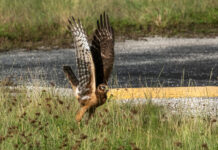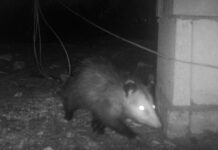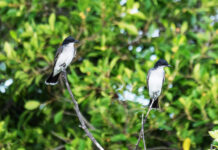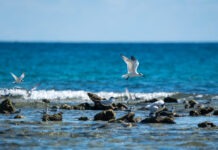Mark Whiteside texted me Saturday afternoon that he’d seen a pair of smooth-billed anis at Fort Zachary Taylor.
Anis are pretty common in the Caribbean and South America, and used to be relatively common – or at least easily findable – in South Florida. I remember seeing my first small gang of them out the window of a classroom at Fairchild Tropical Gardens up in Miami while I was taking the Florida Master Naturalist course.
There were four or five of them. One of the anis had a wriggling Cuban anole in its bill; the anole’s tail was whipping back and forth while the ani tried to gain enough control over the lizard to gulp it down. It played out like one of those 1960s stop-motion dinosaur/monster movies, but in miniature. It was a fine first impression.
Anis are about the size of a blue jay, all black with iridescent edges on their feathers and a bill shaped like a guitar pick. Their posture often includes a slight forward hunch, which makes them look like the goth members of the cuckoo family, which makes sense, as they are members of the cuckoo family. As far as I can tell, the smooth-billed ani is the only bird with “smooth” in its name.
They were actually unknown in Florida until the 1930s. Then they were found breeding near Lake Okeechobee. By the mid-1970s they were distributed as widely as Jacksonville, St. Petersburg and Miami. Then their numbers slowly began to decline. You could find populations, like the one at Fairchild, but those too began to diminish. Back when I was guiding, I remember driving around the weedy lots of Fort Lauderdale for two solid days with a couple who really, really, really wanted to see anis. They did not cooperate.
Anis have never been common to the Keys, but they have been persistently uncommon, being seen every year or so. I’ve seen them at Fort Zach a few times, at Indigenous Park and once on Sugarloaf. It is almost always an individual bird, but I did once see a group of six out at the Marquesas. It’s possible they are living life mostly undisturbed out in the refuge. It’s possible they were strays from Cuba.
A week-and-a-half ago, Adrianna Nelson saw one up at the Florida Keys Hawkwatch at Curry Hammock on Grassy Key.
Smooth-billed anis in the Keys don’t tend to stick around. Most are not re-found after their initial sighting. So I was not overwhelmed with hope when I finally made it over to Fort Zach on Monday morning to look for them.
As I was walking along the edge of the moat, heading toward where Whiteside had said he’d seen the birds, I was mostly thinking about the End Times. Not out of any sense of doom and gloom, but because of the seagrapes.
A couple years ago I started thinking about what skills I had in case of an apocalypse. Semi-professional birdwatching probably would not be of much use. Nor was writing wise-ass birding columns. I have some rudimentary carpentry skills, but they generally rely on power tools, and there’s a good chance power will be hard to find in a post-apocalyptic world.
At some point I hit upon the idea of booze. Anyone who can make booze will always be able to survive, especially in a barter society. Wine and beer would be good, but if you’re trying to carry around alcohol in a carless landscape, distilled spirits would be a better idea. Transportability would also increase your customer base and keep you competitive.
Distilled spirits require a still, which wouldn’t be too hard to make. The problem would be heating the mash to release the alcohol, which requires a lot of energy. Traditionally this is done with fire. You wouldn’t want to consume a lot of resources in a world with limited options so I came up with the idea of a solar still to avoid such wastefulness. I could use magnifying glasses to harness the near-infinite energy of the sun to send heat to the boiler.
Problem solved, the next question was, what easily grown, locally available, climate-stable fruit could you ferment to create the mash? For years I’ve had the idea of seagrapes, as they are plentiful in Florida and pretty hard to kill. I’d also heard that some Conchs even used to make wine out of them.
The hitch in my plan came about a few weeks ago when I was hanging out with birdwatching guide and bird artist extraordinaire Rafael Galvez. We were standing there talking when he reached down, plucked a dark fruit from a sea grape bush and just threw it in his mouth. I’d never actually thought to eat a sea grape before, so I tried one. And it was pretty good – a little tart, a little tangy. But my whole post-apocalyptic plan came crashing down in an instant. A good 98% of the thing was seed. It would probably take 200 of them and a lot of work to even fill a shot glass. Distilling would reduce said shot glassful to a fraction of its volume. How was I supposed to create wealth and power in a post-apocalyptic world with something so labor-intensive?
Anyhow, while I was looking for those anis, my path was lined with seagrape after seagrape, as if to mock me. I was broken out of this micro fugue by a distant sound, indistinct but odd enough to raise my hopes. It increased in volume as I entered the hammock on the far end of the open field.
It’s thick in there, with acacias and buttonwoods and tons of other trees, but eventually I caught a glimpse of one of the anis hopping through the trees, then I caught a glimpse of the second one. Anis’ calls always sound kind of fake to me, like a digital creation, a clarion on a very small submarine. But I was also hearing another call I’d never heard before, like a baby nucking on a pacifier, but also kind of electronic.
I spent a long time trying to follow them through the thickets. Oddly, the smooth-billed anis I’ve seen in the Caribbean and South America are always gregarious, not shy about people at all. But all those I’ve seen in Florida in recent years have mostly been shy and stealthy. Which makes me think their temperaments in that regard may be learned, as opposed to innate.
I was nearly done trying to catch a glimpse when they started flying out of the hammock and into the small wedge of native plants that is mostly surrounded by spartina grass. They disappeared down into the grass, then came up with dragonflies in their mouths, first one ani, then the second, then a third.
It was very cool to learn there were more birds than we thought. I took pleasure in that notion until I got halfway back to the car. Then I started to wonder if it would be possible to ferment coconuts.



